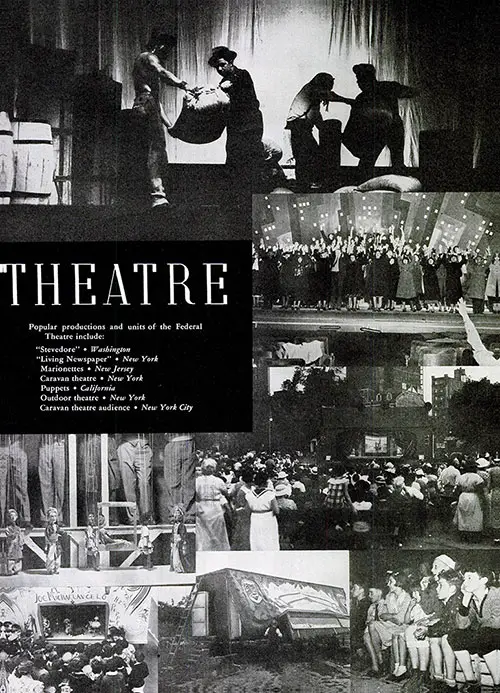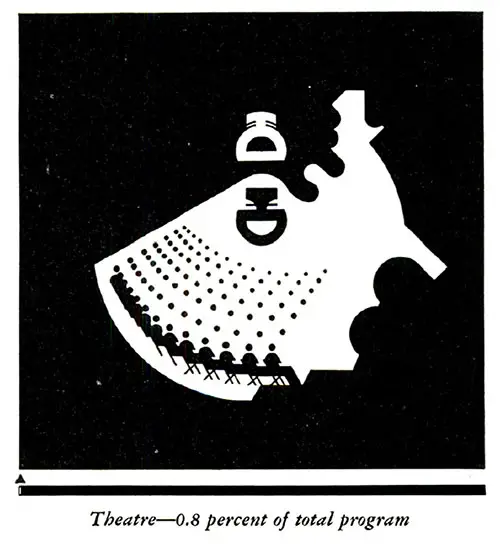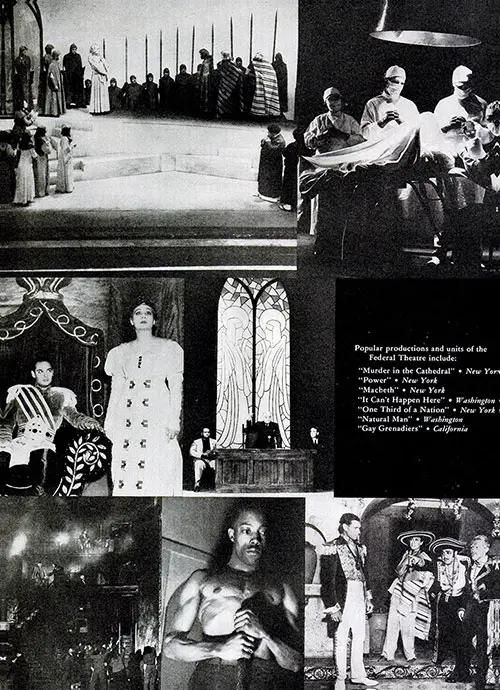WPA Federal Theatre Project - 1938

Popular Productions and Units of the WPA Federal Theatre Include "Stevedore" (Washington), "Living Newspaper" (New York), Marionettes (New Jersey), Caravan Theatre (New York), Puppets (California), Outdoor Theatre (New York), Caravan Theatre Audience (New York). Inventory: An Appraisal of Results of the Works Progress Administration, Washington, DC: US Government Printing Office, 1938. GGA Image ID # 1526f7d18b
The WPA Federal Theatre Project, designed to give work to the theatre's unemployed, has brought living drama to millions of people through a total of 1,501 productions of all types, in 40 cities of 22 States.

Theatre—0.8 Percent of Total Program. Inventory: An Appraisal of Results of the Works Progress Administration, Washington, DC: US Government Printing Office, 1938. GGA Image ID # 1527848418
The Federal Theatre gives an average of 2,833 performances each month—nearly 100 per day—to a total average monthly attendance of more than 1,000,000 people. Sixty-five percent of these shows are free, and they are staged not only in city theatres but in community halls, tents, schools, prisons, armories, churches, parks, hospitals, and CCC camps.
Even when admission is charged it is nominal. Nearly two-thirds of those who have seen these plays, it has been found by the use of questionnaires, never before had seen a play with living actors.
At its peak, the Federal Theatre employed 12,700 actors, designers, technicians, play- wrights, theatre musicians, stagehands, ushers, maintenance workers, and box-office, accounting, and secretarial people. The number is now about 8,700. More than nine out of ten of these workers come from the relief rolls, and $9 out of every $10 of the appropriation goes for wages.
There are the essential operating facts concerning the WPA project designed to give work to the theatre3s unemployed, one of the groups hardest hit by depression and by advances in technology.
As with the other arts projects, it was based on the idea that artists can get just as hungry as laborers, that their training has been expensive and is an asset worth saving, and that their best chance for private jobs lies in the field they know best.
But if these show-people were to get back into the private theatre they had to demonstrate their ability; and if the living theatre was to be revived by recreating a demand for it, the productions had to be vivid, vital, and compelling.
The Federal Theatre undertook this awesome objective in the face of many handicaps. With little money to spend on elaborate staging, it worked out simple and striking techniques through the use of light and shadow.
It delved deeply into rich historical aspects of national development, faced controversial current problems with arresting courage. The verdict on its artistry is best given by a few of the many critics who praised its work.
Sinclair Lewis voiced his "tremendous enthusiasm," and released the dramatization of his anti-dictatorial It Can't Happen Here for simultaneous production by 21 Federal Theatre units.
Samual Eliot Morrison, professor of history at Harvard, expressed his "hearty approval," while Burns Mantle declared the project "has turned the theatre back to the people, to whom it rightfully belongs."
Gilbert Seldes said in 1936, "The Federal Theatre was, at the end of last season, by far the most interesting, and probably the most successful of theatre impresarios in New York."
Paul Green, the teacher and playwright, called it "the most important thing ever to occur in the history of the American drama." Others who have found merit in its work are too numerous to list, but they include such names as Atkinson, Garland, Stevens, Lewis, Brown, Lockridge, Young, Rosen field, Oliver, Hay, Glass, Davney, Graves, Whitman, and Sugarman.
Federal Theatre productions are of many types. In the "purely entertainment" cate- gory would fall circuses, marionette shows, musical comedies, Gilbert and Sullivan and other light operas, and a series of satirical musical revues designed to use a wide variety of vaudeville talent.
The classical aspect of the theatre is represented by such plays as the Negro Macbeth, Marlowe's Dr. Faustus, Coriolanus and Trojan Incident. George Bernard Shaw and Eugene O'Neill, both of whom have approved Nationwide WPA cycles of their plays, also merit this classification.
The project emphasizes important dance groups, as in New York, Chicago, and Los Angeles; the theatre of youth, with such plays as Hansel and Gretel, Pinocchio, and Treasure Island; the Negro theatre, with special units where feasible; and the radio.
In addition to the research and experimentation necessary to its new approach, the project is studying the theatre as a force in education, therapy, and prison welfare. Its hand marionette companies work in hospitals with children whose hands are paralyzed.
Marionette companies in Buffalo and Miami have dramatized Death Takes the Wheel and are used by local police to campaign against reckless driving.
The largest field of the Theatre Project, however, is that of new plays based on American life, whether involving legendary or historic figures such as John Bunyan, Davy Crockett, John Brown, and Abraham Lincoln, or dealing with current problems, as in the Living Newspaper treatments of such moot topics as agriculture, housing, power, and labor.
As to rehabilitation of the workers, more than 1,500 have returned to private jobs, and almost every Broadway cast in 1937-38 contained actors from the project. Examples—Shadow and Substance, Of Mice and Men, You Can't Take It With You, I'd Rather be Right. And the Mercury Theatre, new dramatic group, drew producer, director, designer, and many leading actors from the Federal Theatre.

Other Popular Productions and Units of the WPA Federal Theatre Include "Murder in the Cathedral" (New York), "Power" (New York), "Macbeth" (New York), "It Can't Happen Here" (Washington), "One Third of a Nation" (New York), "Natural Man" (Washington), "Gay Grenadiers" (California). Inventory: An Appraisal of Results of the Works Progress Administration, Washington, DC: US Government Printing Office, 1938. GGA Image ID # 15273edade
"Theatre," in Inventory: An Appraisal of Results of the Works Progress Administration, Washington, DC: US Government Printing Office, 1938, pp. 75-78.

